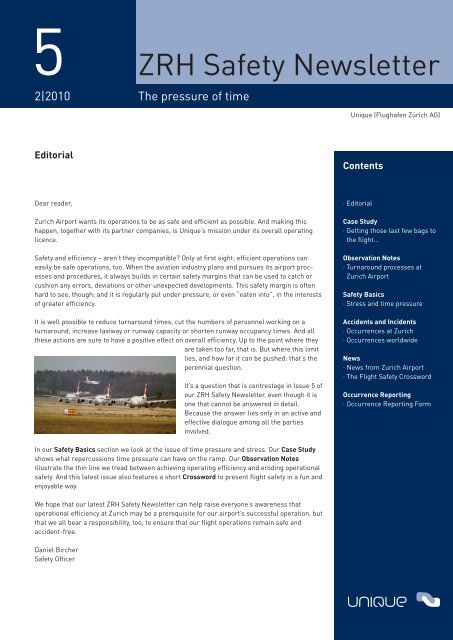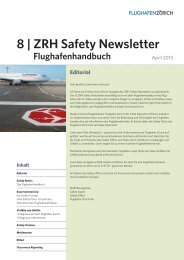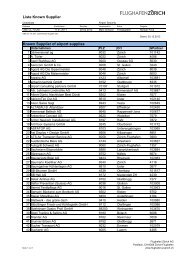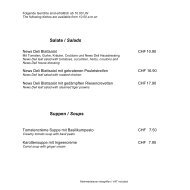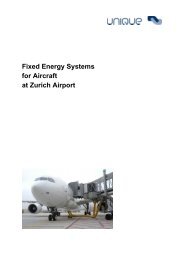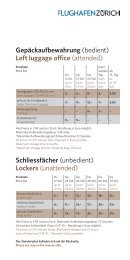ZRH Safety Newsletter 5 - Zurich Airport
ZRH Safety Newsletter 5 - Zurich Airport
ZRH Safety Newsletter 5 - Zurich Airport
You also want an ePaper? Increase the reach of your titles
YUMPU automatically turns print PDFs into web optimized ePapers that Google loves.
52|2010<br />
Editorial<br />
Dear reader,<br />
<strong>ZRH</strong> <strong>Safety</strong> <strong>Newsletter</strong><br />
The pressure of time<br />
<strong>Zurich</strong> <strong>Airport</strong> wants its operations to be as safe and efficient as possible. And making this<br />
happen, together with its partner companies, is Unique’s mission under its overall operating<br />
licence.<br />
<strong>Safety</strong> and efficiency – aren’t they incompatible? Only at first sight: efficient operations can<br />
easily be safe operations, too. When the aviation industry plans and pursues its airport processes<br />
and procedures, it always builds in certain safety margins that can be used to catch or<br />
cushion any errors, deviations or other unexpected developments. This safety margin is often<br />
hard to see, though; and it is regularly put under pressure, or even “eaten into”, in the interests<br />
of greater efficiency.<br />
It is well possible to reduce turnaround times, cut the numbers of personnel working on a<br />
turnaround, increase taxiway or runway capacity or shorten runway occupancy times. And all<br />
these actions are sure to have a positive effect on overall efficiency. Up to the point where they<br />
are taken too far, that is. But where this limit<br />
lies, and how far it can be pushed: that’s the<br />
perennial question.<br />
It’s a question that is centrestage in Issue 5 of<br />
our <strong>ZRH</strong> <strong>Safety</strong> <strong>Newsletter</strong>, even though it is<br />
one that cannot be answered in detail.<br />
Because the answer lies only in an active and<br />
effective dialogue among all the parties<br />
involved.<br />
In our <strong>Safety</strong> Basics section we look at the issue of time pressure and stress. Our Case Study<br />
shows what repercussions time pressure can have on the ramp. Our Observation Notes<br />
illustrate the thin line we tread between achieving operating efficiency and eroding operational<br />
safety. And this latest issue also features a short Crossword to present flight safety in a fun and<br />
enjoyable way.<br />
We hope that our latest <strong>ZRH</strong> <strong>Safety</strong> <strong>Newsletter</strong> can help raise everyone’s awareness that<br />
operational efficiency at <strong>Zurich</strong> may be a prerequisite for our airport’s successful operation, but<br />
that we all bear a responsibility, too, to ensure that our flight operations remain safe and<br />
accident-free.<br />
Daniel Bircher<br />
<strong>Safety</strong> Officer<br />
Unique (Flughafen Zürich AG)<br />
Contents<br />
· Editorial<br />
Case Study<br />
· Getting those last few bags to<br />
the flight…<br />
Observation Notes<br />
· Turnaround processes at<br />
<strong>Zurich</strong> <strong>Airport</strong><br />
<strong>Safety</strong> Basics<br />
· Stress and time pressure<br />
Accidents and Incidents<br />
· Occurrences at <strong>Zurich</strong><br />
· Occurrences worldwide<br />
News<br />
· News from <strong>Zurich</strong> <strong>Airport</strong><br />
· The Flight <strong>Safety</strong> Crossword<br />
Occurrence Reporting<br />
· Occurrence Reporting Form
Getting those last few bags to the flight…<br />
The facts in brief<br />
On 14 November 2008, at 05:45 local time, a<br />
Bombardier CL-600 of Northwest Airlines<br />
arriving at Detroit Metro Wayne County <strong>Airport</strong><br />
collided with a baggage tug belonging to Delta<br />
Air Lines as it was taxiing to its gate. The<br />
aircraft suffered substantial damage, and the<br />
driver of the baggage tug sustained minor<br />
injuries. The aircraft’s crew and 17 passengers<br />
were uninjured.<br />
The background<br />
The flight had landed uneventfully on the<br />
airport’s Runway 22L. The aircraft was<br />
instructed by Ground Control to proceed via<br />
taxiways Kilo and Quebec 3 and to hold short<br />
of Taxiway Quebec. The pilots were then<br />
cleared to proceed via Taxiway Quebec from<br />
north to south to arrive at Gate C7. (Traffic<br />
here usually goes from south to north, but<br />
such clearance is given in the peripheral<br />
hours when ground traffic is light.) According<br />
to his own account, the ramp controller could<br />
see the aircraft clearly. The weather conditions<br />
at the time of the collision were: wind<br />
170°, eight knots, fog, 7 kilometres visibility<br />
and light rain.<br />
The baggage tug driver has started his shift at<br />
05:15. This was the second day of a four-day<br />
block of ten-hour shifts. That morning he<br />
found that he had been assigned to “baggage<br />
running” duties. He grabbed his radio and<br />
drove to the Terminal A baggage hall to load<br />
some last-minute baggage for a Delta Air<br />
Lines flight to Atlanta (ETD 05:55). He picked<br />
up the baggage and drove it back towards<br />
Terminal B/C. In doing so he took one of the<br />
roadways between terminals A and B/C. It was<br />
dark and rainy, and he could not see any<br />
traffic along his route. But as he crossed the<br />
taxiway, he was suddenly surprised by the<br />
sound of aircraft engines. He had a glimpse of<br />
a fuselage, and then the aircraft collided with<br />
his tug.<br />
The baggage tug impacted with the aircraft<br />
about halfway down the left wing, and ended<br />
up near the wing-to-fuselage fairing. The tug<br />
driver was ejected from the tug and lay<br />
unconscious on the tarmac for some time.<br />
Investigation findings<br />
The following factors were found to have<br />
contributed to the accident:<br />
• The baggage tug driver had hardly arrived at<br />
work before he was required to set off and<br />
load the last-minute baggage.<br />
• The baggage tug driver had not informed<br />
himself about the current taxiing arrangements<br />
before starting his shift.<br />
• The Bombardier CL-600 was asked to taxi<br />
from north to south instead of the usual<br />
south-to-north arrangement.<br />
Source: National Transportation <strong>Safety</strong> Board<br />
Schematic representation.<br />
2<br />
Case Study<br />
Bombardier<br />
Terminal A CL-600<br />
Terminal B/C<br />
Baggage tug<br />
Twy Quebec<br />
In this section we look at a concrete example<br />
of a safety incident relating to our focus<br />
topic, describing the incident in detail and<br />
highlighting the lessons to be learned.<br />
Collision<br />
Gate C7<br />
N
Conclusions<br />
This case study illustrates two aspects of<br />
safety. First: pressure of time and the lack of<br />
an overall overview that poor weather can<br />
lead to will tend to create more favourable<br />
conditions for accidents to occur. Second:<br />
inherent system weaknesses and unfavourable<br />
design – e.g. roadways crossing taxiways<br />
– will also make incidents more likely to<br />
occur. <strong>Zurich</strong> <strong>Airport</strong> has similar design<br />
2<br />
2<br />
4<br />
6<br />
13<br />
6<br />
7<br />
2<br />
79<br />
4<br />
6<br />
8<br />
8<br />
8<br />
7<br />
1<br />
weaknesses of roadways crossing taxiways.<br />
When these conditions combine with time<br />
pressure and simply unexpected events,<br />
operational hazards may arise.<br />
The map below shows the locations of cases<br />
in which right-of-way was not observed by<br />
vehicles meeting aircraft at roadway/taxiway<br />
crossings at <strong>Zurich</strong> <strong>Airport</strong> in 2008 and 2009.<br />
Grafik: <strong>Safety</strong> Office<br />
Number of non-observances of right-of-way by vehicles meeting aircraft during pushback,<br />
taxi into or taxi out of stands.<br />
Number of non-observances of right-of-way by vehicles meeting aircraft on taxiways.<br />
4<br />
2<br />
1<br />
3 Case Study
“Everything has to be done quickly here.<br />
It’s time that’s always the problem.”<br />
By Kyung-Jin Ha and Daniel Huber<br />
It’s 11:00 as our aircraft taxis from its landing<br />
runway to its stand, and <strong>Zurich</strong> <strong>Airport</strong> is its<br />
usual busy self at this time of day. As we get<br />
out of the car, we are greeted by a wall of<br />
sound. The sheer noise and the wet and cold<br />
weather are enough to raise our stress levels,<br />
and simply concentrating becomes an art in<br />
itself. That’s why ear protectors are a must.<br />
Most of the aircraft around us are surrounded<br />
by more than five apron vehicles. They are<br />
performing various tasks: fuelling, toilet<br />
servicing, cleaning, providing electricity. To<br />
obtain more information on the various work<br />
processes involved, we try to talk to some of<br />
the ramp personnel. But they’re all in a hurry,<br />
and wave us away.<br />
Just as we are about to drive off, we see the<br />
ramp coordinator. We hurry over to him and<br />
ask if he can tell us something about the<br />
turnaround process at <strong>Zurich</strong> <strong>Airport</strong>. His<br />
answer: “Everything has to be done quickly here.<br />
The Airbuses A319/320/321 and Avro RJs have<br />
turnaround times of 35 to 40 minutes. The ramp<br />
staff, the cleaners, the fuellers and the crew:<br />
everyone has to work flat out. The problem is the<br />
short turnaround times that the airlines insist<br />
on. We just have to keep to them.” Pressure of<br />
time is clearly a major turnaround issue. We<br />
decide to gain our own impressions of the<br />
turnaround process, and head off to the India 9<br />
stand.<br />
It’s 11:08 when an Avro RJ pulls up at India 9.<br />
The ramp staff rush to the aircraft, put on the<br />
chocks and arrange the safety cones. It’s all<br />
done in seconds. The baggage tug drivers<br />
open the cargo door to start unloading the<br />
bags. Meanwhile, the passengers disembark<br />
and get into their apron buses. At 11:11 –<br />
three minutes after parking – the cleaning<br />
vehicle arrives. By 11:15 the toilet servicing<br />
truck is attaching its hose. With the fleet of<br />
vehicles now in attendance, it all looks a little<br />
chaotic.<br />
Deboarding is complete: the buses shut their<br />
doors and head off to the terminal. Time to<br />
give the cabin a thorough clean. The driver of<br />
the cleaning truck runs up to us and shouts,<br />
“These bus drivers: they always park so that I<br />
can’t get through. But I’ve got my work to do,<br />
too!” We smile. But we also appreciate that<br />
he’s got his timetable to keep to just as the<br />
bus drivers have.<br />
By 11:16, the cleaning team is on board. The<br />
fuelling truck is here, too, and the fuelling<br />
agent is fitting the hose to the plane. By 11:19,<br />
the toilet servicing vehicle and the baggage<br />
tugs have done their work at the aircraft and<br />
withdraw from the scene. By 11:24 the<br />
cleaning crew are also done: they race down<br />
the airstairs and get into their car. Our friend<br />
from the cleaning company gives us a quick<br />
wave. We suddenly notice that none of the<br />
cleaners are wearing ear protectors: how can<br />
they work on the apron all day like that?<br />
By chance, we then meet the departing flight’s<br />
4<br />
Observation Notes
first officer, who is performing his walkaround<br />
check. How does he feel about the<br />
short turnaround times at <strong>Zurich</strong>? “Everything<br />
works really well and fast here,” he replies.<br />
“That’s not always the case at other airports. The<br />
ramp people here do a great job: they’re really<br />
very professional. But I can see, of course, that<br />
they’re under a lot of time pressure.”<br />
“The people who work on the apron here also<br />
have to cope with very cramped conditions,” he<br />
continues. “When two buses pull up and one of<br />
them isn’t even half-full because it only has<br />
Business Class passengers on it, that’s pretty<br />
annoying. The space shortage this causes is<br />
serious, and it affects all the other ramp<br />
handling processes.”<br />
11:30. The apron bus brings out the new<br />
passengers. We are amazed: the whole ramp<br />
handling process has taken less than half an<br />
hour, and the aircraft will soon be on its way<br />
again. As our first officer confirmed, everyone<br />
involved in the turnaround process does a<br />
huge amount of work in a very short time.<br />
The stress is written on their faces, though.<br />
Everyone wants to do a good job. And in all the<br />
hectic, it’s bound to happen from time to time<br />
that a regulation or a safety distance fails to be<br />
observed. This time it didn’t, and the whole<br />
handling process functioned flawlessly. The<br />
safety margin was clearly generous enough.<br />
5<br />
Observation Notes
Conclusions<br />
So how big is this “safety margin”? To<br />
answer that question, we need to look at the<br />
incidents and accidents that occur in our<br />
flight operations, and especially in our<br />
turnaround processes. From these investigations<br />
we can conclude, for example, that:<br />
1. many of the people involved in incidents or<br />
accidents seem to have failed to properly<br />
assess the situation;<br />
2. they all seem to have been performing<br />
their work under sizeable stress or time<br />
pressure;<br />
3. distractions, not following instructions,<br />
failing to keep to prescribed work procedures<br />
and miscommunications are<br />
frequently named as factors in the<br />
accidents that occur.<br />
The chart below shows the “causal factors”<br />
in accidents at <strong>Zurich</strong> <strong>Airport</strong> in 2008 and<br />
2009, as cited by the persons involved.<br />
Causal factors cited for accidents at <strong>Zurich</strong> <strong>Airport</strong>, 2008–2009<br />
No assistance available<br />
Misread situation<br />
Distraction<br />
Stress/time pressure<br />
Procedure not observed<br />
Instructions not followed<br />
Right-of-way ignored<br />
Miscommunication<br />
Inadequate training<br />
Apparently obvious solutions (more space,<br />
more time, more training etc.) are certainly<br />
good starting points. But these do tend to<br />
focus on only part of the problem. The best<br />
approach is to find the right balance between<br />
Number of citations (multiple causes could be given)<br />
Grafik: <strong>Safety</strong> Office<br />
safety and efficiency, and thereby ensure that<br />
the safety margin does not become too slim.<br />
It’s a balancing act; and it’s one of which we<br />
must all be constantly aware.<br />
6<br />
Observation Notes
Stress and time pressure<br />
General remarks<br />
Stress is a reaction by the body to internal or<br />
external threats. It’s a response which<br />
demands strengths of us that go beyond our<br />
usual “operating” intensity; and if the causes<br />
of the stress and our response to it extend<br />
over a longer period of time, this can be<br />
damaging to our health. Stress tends to<br />
fatigue us and exhaust us and, as a result, we<br />
may fail to notice certain signals or be unable<br />
to concentrate to the required degree.<br />
The factors that can cause stress in our ramp<br />
work at the airport include:<br />
• time pressures<br />
• continuous noise (such as from engines or<br />
radios)<br />
• poor lighting<br />
• a confusing traffic situation<br />
• weather conditions (heavy rain, cold, heat,<br />
wind).<br />
The signs that we are suffering from stress<br />
include:<br />
• forgetfulness and lapses of concentration<br />
• irritability<br />
• hectic driving and working styles<br />
• chronic fatigue<br />
• making mistakes and/or poorly perceiving<br />
and assessing situations.<br />
People are very different in their character,<br />
their behaviour and their degrees of flexibility.<br />
And it is this sheer variety that leads to certain<br />
weaknesses in the man/machine interaction.<br />
We all react in many different ways, and each<br />
have our own physical and mental limits; and<br />
if we are pushed beyond these, we will be<br />
more likely to make errors or fail to observe<br />
regulations and procedures.<br />
Stress and time pressure: critical work<br />
situations at <strong>Zurich</strong> <strong>Airport</strong><br />
Aircraft land and take off at <strong>Zurich</strong> <strong>Airport</strong> in a<br />
clear and coordinated pattern. The work<br />
required to handle these movements must<br />
also be swift and well coordinated if <strong>Zurich</strong> is<br />
to remain competitive on the international<br />
airport scene. This means that ground<br />
handling, too, must be performed as quickly<br />
as possible. The work here is often very<br />
demanding, though, and requires high degrees<br />
of concentration and attention.<br />
Time pressure is a prime and constant stress<br />
factor at <strong>Zurich</strong> <strong>Airport</strong>. And this pressure of<br />
time can cause wrong decisions to be made. In<br />
stress situations, people will tend to fall back<br />
on automated decisions, rather than thinking<br />
things through and responding to the actual<br />
situation with which they are faced. Work<br />
processes may be shortened, for example: an<br />
apron vehicle may be driven 10–15 km/h above<br />
the speed limit, or the safety distances<br />
between vehicle and aircraft may not be<br />
maintained, putting other parties in danger,<br />
too.<br />
Stress management<br />
Here are a few tips for reducing stress<br />
symptoms (or even preventing them<br />
developing) in our airport work and operations:<br />
• Wear ear protectors, to reduce the<br />
permanently-high noise levels in the ramp<br />
and apron areas.<br />
• Practise effective time management:<br />
– get to work in good time<br />
– plan enough breaks<br />
– make good use of these breaks.<br />
• Familiarise yourself in good time with any<br />
changes to ramp and apron procedures, so<br />
that you won’t forget how to act and react<br />
in a stress situation.<br />
• Communicate with everyone else involved,<br />
to avoid misunderstandings and take the<br />
right actions when required.<br />
• <strong>Safety</strong> first! Even under time pressure,<br />
always make safety your paramount<br />
priority – and don’t be afraid to say “no” if<br />
something really can’t be done.<br />
Further information (in German)<br />
http://www.psychologie.ch/de/publikationen/<br />
medien/archiv_medien/deutlich mehr stress<br />
am arbeitsplatz.html<br />
Stress check<br />
http://www.stressnostress.ch/d/04-check/<br />
Check1/check.php<br />
7 <strong>Safety</strong> Basics<br />
“<strong>Safety</strong> Basics” is the section in each <strong>Safety</strong><br />
<strong>Newsletter</strong> where we provide key information<br />
on the rules, regulations and procedures<br />
for the safety item we’re focusing on.
Occurrences at <strong>Zurich</strong> <strong>Airport</strong><br />
Highloader collides with aircraft’s cargo door<br />
The incident occurred when a highloader was<br />
unloading a flight on Stand D06. With space<br />
tight around the aircraft, the highloader driver<br />
had to move his vehicle several times. While<br />
doing so, he failed to notice the aircraft’s open<br />
cargo door, which collided with his cab. The<br />
bottom edge of the door was dented by the<br />
impact. The damage was later repaired.<br />
Photo: Unique<br />
GPU cable forgotten<br />
Three cases occurred between October 2009<br />
and February 2010 in which the external<br />
power supply to the aircraft was not disconnected<br />
before the ground power unit (GPU)<br />
was taken away.<br />
Engine collides with airbridge<br />
This incident occurred to an Airbus A320<br />
which, after landing, was taxiing to its<br />
assigned stand of A13. As it was doing so, the<br />
ramp supervisor suddenly noticed that the<br />
aircraft had not stopped when instructed by<br />
the stand’s parking guidance system. He<br />
immediately told all the staff in the vicinity to<br />
leave, grabbed the chocks and other items<br />
lying around and fled. The aircraft rolled into<br />
the A75 airbridge with its left engine. Fortunately,<br />
there were no injuries among the<br />
ground staff, passengers or aircraft crew.<br />
The <strong>Safety</strong> Office adds:<br />
Routine processes and procedures should<br />
be regularly checked:<br />
• Keep to all designated routes and maintain<br />
all distances around aircraft.<br />
• Wait till the aircraft has come to a standstill,<br />
the chocks have been applied and the<br />
anti-collision light is off.<br />
• Check yourself to see that all cables have<br />
been disconnected before removing<br />
equipment.<br />
FOD damage to an Emirates Boeing 777<br />
In this incident, which occurred on 14 January<br />
2010, the technical staff at Stand E53 found a<br />
metal pin embedded in a tyre on the aircraft’s<br />
main landing gear during their outside check.<br />
The pin had penetrated the tyre so deeply that<br />
it had to be replaced. The cost of the new tyre<br />
was around CHF 10 000. As a result of the tyre<br />
change, the flight’s departure was also<br />
delayed. According to SR Technics, the tyre<br />
must have been damaged after the aircraft<br />
had landed, so the pin must have been lying on<br />
the ground in <strong>Zurich</strong>.<br />
metal pin<br />
The <strong>Safety</strong> Office adds:<br />
Foreign object debris (FOD) – items lying<br />
around – causes damage to aircraft costing<br />
millions of francs every year. In view of this,<br />
every ramp and apron worker is required to:<br />
• clear up their workplace before leaving it<br />
and<br />
• remove any waste or other items they find<br />
on stands, in taxi areas or on airport<br />
roadways.<br />
If you can, please place any such items you<br />
find in the special yellow FOD bins.<br />
8<br />
Photo: Unique<br />
Accidents and Incidents<br />
The <strong>ZRH</strong> <strong>Safety</strong> <strong>Newsletter</strong> is intended to<br />
sensitise readers to the potential dangers<br />
inherent in all operations at <strong>Zurich</strong> <strong>Airport</strong>.<br />
To this end, every issue includes a section<br />
reporting on recent occurrences at <strong>Zurich</strong><br />
and elsewhere.<br />
Photo: Unique
Occurrences worldwide<br />
Cessna jet blast injures ramp worker<br />
A line maintenance worker was seriously<br />
injured by jet blast at McElroy <strong>Airport</strong> (Colorado,<br />
USA) on 23 August 2009. As the aircraft<br />
– a Cessna C-560 – was taxiing to the fuelling<br />
stand, the line maintenance worker noticed<br />
that it was blowing grass onto the apron area.<br />
He asked the pilot to blow away the grass<br />
when taxiing away, so that he (the worker)<br />
would not have to clean the area himself. After<br />
fuelling, the aircraft turned with a higher<br />
engine thrust; and the worker, who was some<br />
60 metres away, was blown away by the jet<br />
blast. He suffered a broken leg. The worker<br />
had undergone safety training, but was not<br />
sure whether this had included warnings on<br />
the dangers posed by jet blast.<br />
Near-collision between a landing and taxiing<br />
aircraft<br />
A near-collision occurred at Frankfurt <strong>Airport</strong><br />
on 8 March 2009 between a landing Boeing<br />
747-400 and a taxiing Bombardier DHC8-Q400.<br />
The DHC8 had been pushed back from the<br />
V108 parking position. It was then instructed<br />
to taxi towards Runway 25L via Taxiway A and<br />
hold before Taxiway D. The cockpit crew only<br />
acknowledged taxiing along Taxiways A and D,<br />
however. The aircraft then proceeded along<br />
Taxiways A and D and stopped at the holding<br />
point for Runway 25R.<br />
At the same time, a Boeing 747 with 370<br />
passengers and 22 crew was on final approach<br />
to Runway 25R. The 747 flew over the DHC8<br />
– which was then standing at the point where<br />
Taxiway D meets the runway – at a height of<br />
around 15 metres.<br />
1. DHC8’s taxi route (red)<br />
2. Boundary of authorities of Apron Control and Tower<br />
(green)<br />
Source: German BFU Bulletin, March 2009<br />
Landing gear collides with vehicle<br />
Cargolux flight 7933 touched a maintenance<br />
vehicle when landing on Runway 24 at<br />
Luxembourg Findel <strong>Airport</strong> on 21 January<br />
2010. The incident occurred under Category III<br />
conditions with a cloudbase of 100 metres and<br />
a runway visual range of less than 350 metres.<br />
The Cargolux Boeing 747 touched the roof of<br />
the vehicle as it was landing at 12:53. Both the<br />
vehicle and the aircraft’s landing gear were<br />
damaged. The vehicle was on the runway to<br />
repair the runway lighting. The incident is still<br />
being investigated.<br />
9<br />
Accidents and Incidents
News<br />
<strong>Zurich</strong> <strong>Airport</strong> recertificated<br />
<strong>Zurich</strong> <strong>Airport</strong> was successfully recertificated<br />
by the Swiss Federal Office of Civil Aviation<br />
(FOCA) on 17 December 2009.<br />
Web-based safety training<br />
Background<br />
The International Civil Aviation Organisation<br />
(ICAO) and the FOCA require all airport<br />
employees to undergo safety training. In view<br />
of this, Unique has developed a web-based<br />
safety training programme. The aim of this<br />
training is to prevent accidents and incidents<br />
in our flight operations. The new web-based<br />
safety training centres on: the safety management<br />
system (SMS), runway safety, ramp<br />
safety and human factors.<br />
Any employees wishing to complete Unique’s<br />
new web-based safety training can obtain the<br />
appropriate system access authorisation from<br />
their superior (if they are at Unique) or via<br />
their training officer (if they are with a partner<br />
company). This arrangement is intended to<br />
ensure that all airport personnel receive the<br />
same standardised safety training. For further<br />
information here and/or to obtain a system<br />
access authorisation, please send an email to<br />
occurrence@unique.ch<br />
Training required<br />
From April 2010 onwards, anyone holding an<br />
airport ID badge authorising them to access<br />
the V, O or G zones will be required to complete<br />
the new web-based safety training<br />
course when they renew or change their ID (or<br />
have it initially issued). This will ensure that<br />
the new training will gradually be completed<br />
by all airport personnel.<br />
A simple and flexible approach<br />
When they are issued their new airport ID<br />
badge (after April 2010), the employee<br />
concerned will also be given a log-in and a<br />
personal password enabling them to access<br />
the new web-based safety training pages at<br />
any time – from their office, from home or<br />
during their travels. And if they only initially<br />
have time to complete part of the course, they<br />
can log-in again later and will be taken to the<br />
point they previously reached, from which they<br />
can continue.<br />
Web-based safety training is simple and<br />
flexible, while promising good learning<br />
results. We hope you enjoy it, and thank you in<br />
advance for continuing to make your personal<br />
contribution to safety at <strong>Zurich</strong> <strong>Airport</strong>.<br />
10 News
The Flight <strong>Safety</strong> Crossword<br />
The crossword below is made up of various<br />
airport and safety terms (in English and<br />
German). If you get all the answers correct,<br />
the letters in the grey boxes should spell out<br />
the solution. Just send this by 15 April to<br />
Flughafen Zürich AG, <strong>Safety</strong> Office, P.O. Box,<br />
CH-8058 <strong>Zurich</strong> <strong>Airport</strong> or communicate it<br />
Waagrecht<br />
3 Er wird nach einem Unfall ausgefüllt<br />
6 Synonym für Rollhaltebalken<br />
8 Wenn das Flugzeug über den Pistenrand hinaus gerät<br />
(Runway…)<br />
10 Dokument das die Grundhaltung des Flughafens bezüglich<br />
<strong>Safety</strong> beschreibt<br />
11 Überprüfung der Einhaltung von flughafenweiten<br />
Bestimmungen<br />
15 Schnelle von den Triebwerken produzierte Luftströmungen<br />
17 Abkürzung von Low Visibility Procedures<br />
20 Kurze aber gefährliche Ermüdung (z.B. am Steuer)<br />
personally to our <strong>Safety</strong> Office giving your<br />
name, address, email and phone number.<br />
The winners will be drawn from all the entries<br />
received: the first three correct entries drawn<br />
will each win an airport voucher.<br />
Enjoy, and good luck!<br />
Solution<br />
Senkrecht<br />
1 Standort des Bundesamt für Zivilluftfahrt (BAZL)<br />
2 Unsere längste Piste misst 3700 …<br />
4 Abkürzung von Dockleitsystem<br />
5 Ein Flugzeugstandplatz im Süden<br />
7 Kollision zwischen Vögeln und Flugzeugen<br />
9 Abkürzung von <strong>Safety</strong> Management System<br />
12 Enteisungsfahrzeug (Umgangssprache)<br />
13 Abkürzung für Internationale Zivilluftfahrtorganisation<br />
14 Abkürzung für Ground Power Unit<br />
16 Ereignis das grossen Schaden verursacht<br />
18 Verfahren um das Flugzeug vom Standplatz in die richtige<br />
Rollposition zu bringen<br />
19 Wird mehrmals am Tag durchgeführt (Pisten-…)<br />
11 News
!<br />
The Occurrence Reporting Form<br />
Unsafe situations and “near-misses” should never be left unaddressed. We encourage<br />
everyone at <strong>Zurich</strong> <strong>Airport</strong> to communicate any ideas or observations they may have regarding<br />
the safety of flight operations to our <strong>Safety</strong> Office using the form below.<br />
<strong>Zurich</strong> <strong>Airport</strong> Occurrence Reporting Form<br />
1. Basic details<br />
Datum<br />
Time day night dawn dusk<br />
Weather clear cloudy overcast rain fog<br />
Visibility good moderate poor<br />
Surface conditions dry wet snow slush ice<br />
Location<br />
2. Description (what happened?)<br />
3. Causes (why might this have happened?)<br />
4. Proposals (what could be done to prevent this kind of thing happening again?)<br />
5. Personal assessment<br />
a. How likely do you think it is that b. How serious do you think such an<br />
this might happen again? occurrence and its consequences could be?<br />
1 2 3 4 5 1 2 3 4 5<br />
very unlikely very likely harmless disastrous<br />
Any information you give above will be used to help further enhance safety at <strong>Zurich</strong> <strong>Airport</strong>. You can decide yourself whether you wish to<br />
provide your own personal details. If you do, we will cut off and dispose of this section once we have received your form, but will take the<br />
liberty of contacting you if we have any follow-up questions or if anything is unclear. None of the information you provide will be passed on<br />
without your express consent.<br />
When you have completed the form, please mail it or fax it to:<br />
Unique (Flughafen Zürich AG), <strong>Safety</strong> Office, P.O. Box, CH-8058 <strong>Zurich</strong> <strong>Airport</strong>, fax +41 (0)43 816 8363, occurrence@unique.ch<br />
Thank you in advance for playing your own active part in keeping our airport safe.<br />
Last and first name (optional)<br />
Company (optional)<br />
12<br />
Occurrence Reporting<br />
Publishing details<br />
Editorial team:<br />
Unique (Flughafen Zürich AG)<br />
Printed by RTK, Kloten<br />
© Unique (Flughafen Zürich AG)<br />
P.O. Box<br />
CH-8058 <strong>Zurich</strong> <strong>Airport</strong><br />
www.unique.ch<br />
Contributors to this issue:<br />
<strong>Safety</strong> Office, Kyung-Jin Ha,<br />
Peter Frei<br />
The <strong>ZRH</strong> <strong>Safety</strong> <strong>Newsletter</strong><br />
provides regular information and<br />
updates on safety issues at and<br />
around <strong>Zurich</strong> <strong>Airport</strong>. If you have<br />
any contributions or suggestions<br />
of your own, the <strong>Safety</strong> Office<br />
will be pleased to hear from you at<br />
occurrence@unique.ch


